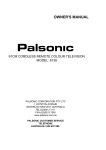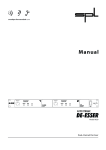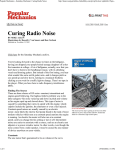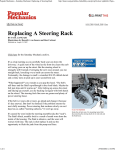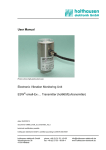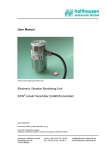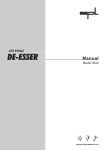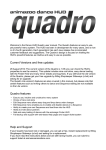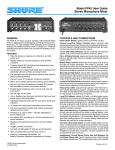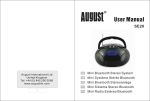Download Silencing Sibilance - Back at the Ranch Studio
Transcript
Silencing Sibilance http://www.printthis.clickability.com/pt/cpt?action=cpt&title=Silen... Powered by SAVE THIS | EMAIL THIS | Close Silencing Sibilance Apr 1, 2000 12:00 PM, Brian Knave WHAT IT IS For those not in the know, a de-esser is just what the word suggests: a device for getting rid of unwanted esses, or sibilance, from vocal tracks. Sibilance can be caused not only by the consonant s, but by several other consonants and digraphs as well, including c, sh, and ch. What's so bad about sibilance? Well, it can sound ugly, even to the point of being painful to listen to. Interestingly, though, people have different tolerance levels for sibilance. I don't mind a little of it, but I know many engineers who can't bear even a trace. On the other hand, I recently mixed an album for two Latin American musicians who wanted me to emphasize the esses on their vocal tracks, as they felt the emphasis helped clarify their Spanish pronunciation. (Most of the time, a bright plate and some high EQ was all it took to make the emphasis.) The point is, there's nothing wrong with esses per se: after all, they are required for the proper pronunciation of our language (and others). The problem arises, however, when they are significantly louder than the rest of the track. It's not uncommon for an inexperienced singer to generate esses that are ten or more decibels hotter than the other consonants and vowels in the performance. Moreover, some singers just have very sibilant voices, no matter how experienced they are in the studio. For such singers, it's especially important to find a mic that will help play down the esses. Another problem is that signal processing often accentuates sibilance. A compressor with a slow attack time, for example, may let the initial sibilant sound in a word pass untouched, while compressing-and thus lowering the level of-the rest of the word. Also, certain effects (for example, bright plates, bright reverbs, and spectral enhancers) may further enhance esses. For that reason, it's generally best to de-ess before applying other signal processing. TRIED AND TRUE The conventional de-esser is basically a fast-acting compressor that is set to attenuate the high frequencies present in sibilant sounds. (Other de-essing technologies are also available, as we'll see.) Nowadays, de-essers are frequently built into voice processors, and, as noted earlier, some companies also offer stand-alone units. The traditional, do-it-yourself approach to de-essing (which is still viable today, of course) requires two pieces of gear: an equalizer and a compressor featuring a sidechain or a key input (also known as a control input). Sidechains and key inputs access circuits that let you customize the response of the dynamics processor. Ordinarily, the compressor's level detector (which responds to amplitude only) is controlled by the main input signal. However, you can take control away from the main signal by introducing a different signal into the sidechain or key input. Pretty much any equalizer, whether parametric or graphic, will work with this application. The quality doesn't matter much, because the EQ is used only to control the operation of the compressor-it's not in the signal path, so it's never actually heard. To make this type of de-esser, first insert the EQ into the compressor's sidechain or key input. A sidechain has send and return jacks, so here it's simply a matter of patching cables from those to the EQ's input and output, respectively (see Fig. 1a). The usual 1 1/4 4-inch TRS Y-cable connects the compressor's audio ins and outs to the vocal track's channel-insert point. A compressor with a key input requires that you first split, or "mult," the signal. This can be done by using a mono Y-splitter connected to the send portion of the 1 1/4 4-inch TRS Y-cable (see Fig. 1b). (An option for those working on an MDM, a digital audio workstation, or a hard disk recorder is to clone the track rather than multing it-a better solution in my book because it avoids level anomalies and signal irregularities endemic to Y-splitters.) After multing the signal, send one to the compressor's audio input and the other to its equalizer input. Last, patch the equalizer's output to the key input on the compressor and the compressor's output back to the channel insert on the receive portion of the TRS Y-cable. Once you're set up, the trick is to boost the frequencies of the sibilant sounds you want to get rid of (these usually occur in the 2 to 10 kHz range) while cutting other, nonproblematic frequencies. Because the equalizer now controls the level detector in the compressor, and it is set to amplify the sounds you don't 1 of 4 7/29/08 10:07 PM Silencing Sibilance http://www.printthis.clickability.com/pt/cpt?action=cpt&title=Silen... want, it tells the compressor to reduce those sounds first. MESSIN' WITH DE-ESSIN' To test the de-essers, I fished through old master tapes and pulled out some tracks I knew had sibilance problems. These were helpful; however, none had enough esses to let me keep the tape rolling and really put the de-essers through their paces. So I wrote and recorded a song and a poem-each brimming with esses-just for the occasion (see the sidebars "De-Ess This!" and "The De-Esser Challenge"). I then made two digital clones of each vocal track, which allowed me to patch all three de-essers simultaneously to the same source material on different channels. ROLL YOUR OWN For the traditional de-esser, I used a Symetrix 552E dual parametric EQ patched into the sidechain of an Aphex Expressor 651 compressor/limiter. I chose the Expressor because, out of five compressors in my rack, it was the most fully featured, offering very exacting attack- and release-time controls, as well as other helpful extras. Getting good results from the compressor/EQ combination took patience and considerable tweaking. Though not rocket science, this de-esser was considerably more difficult to use than either of the stand-alone units, both in terms of setting it up and in finding the optimal settings. Also, it seemed slightly less effective overall. Of course, this was hardly a comprehensive test: many variables are involved in this type of de-essing, and changing any one of them-the source material, the brand and make of the compressor, and so on-would almost certainly yield different results. There are several ways to arrive at usable settings; here's an approach that works for me. Start with a high ratio (10:1, for instance), a moderate threshold (-5 to -10 dB), and fast attack and release times on the compressor. Now, if you're using a parametric EQ, dial in the maximum decibel cut in the de-ess frequency range and then sweep the frequency (with, for example, a one-octave Q) until you hear an increase in sibilance. (With a graphic EQ, raise the bands between 2 and 10 kHz.) After finding the frequencies that emphasize the sibilance, go from cut to boost, boosting until you hear a reduction in sibilance. You can also adjust the bandwidth at this point, broadening it if you need to address a bigger frequency range and tightening it to pinpoint singular esses. Now fine-tune your compressor settings. A higher ratio and/or lower threshold will determine the amount and intensity of ess reduction. Also, play with the attack and release times, the goal being to set an attack that's fast enough to catch initial esses and a release fast enough so as not to compress the rest of the word. This is no time to get creative; rather, strive for a natural, unaffected sound minus the unwanted sibilance. Use the compressor bypass switch to compare processed and unprocessed signals; use makeup gain to balance the levels. Obviously, it's hard to suggest specific settings here, as each situation (and compressor) is different. For the source material I worked with (mostly my own voice), I ended up using a ratio of about 7:1, with the threshold set at around -2 dB for a maximum gain reduction of 12 dB. Attack time was set at 0.05 milliseconds and release time at around 50 milliseconds. I fine-tuned the sound using other features on the Expressor, including a high-frequency "retrieval" circuit comprising two controls: HFX Ratio and Frequency. I dialed in a bit of the HFX Ratio (0.3) at 15 kHz to add some "air" to the processed signal, which helped. I also disengaged the unit's soft-knee control-sibilance transients are fast, and hard-knee compression kicks in faster than soft-knee. But wait-that's not all. To refine the sound further and keep the effect as transparent as possible, I employed two bands on the parametric EQ: one, as described, to reduce esses (via boosting) and the other to instruct the compressor to ignore frequencies below the de-ess range (via cutting), so the whole signal wouldn't compress whenever a sibilant sound occurred. For the de-ess band, I applied 12 dB of boost at around 6 kHz with a 1-octave Q. For the second band, I applied a 10 dB cut at around 1.2 kHz with a 1.5-octave Q. For good measure, I also dialed in the 552E's low-cut filter at 260 Hz-there wasn't likely to be much energy down that low, but just in case, the compressor would know to overlook it. DRAWMER MX50 The Drawmer MX50 Dual De-Esser ($549) employs a conventional de-esser design with both amplitude-and frequency-detection circuits (compressor and EQ), among others, in a single easy-to-use 1U box. Each channel provides four controls (two knobs and two button switches), as well as a bypass switch, and the rear panel provides both balanced XLR (+4 dBu) and unbalanced 1 1/4 4-inch (-10 dBV) I/O. You can use channels independently or link them (via the Stereo Link switch) for stereo operation, which allows both channels to track together without image shifting. The unit has a floating threshold that adapts automatically to the dynamics and level of the incoming signal, so no threshold adjustment is necessary. From left to right, the controls are Frequency, De-Ess, Air, and De-Ess Band. The De-Ess Band control offers two modes of operation: Full and Split, with Split mode functioning similarly to the dual-band application described in the "Roll Your Own" section. That is, in Full mode, when the unit detects user-selected ess frequencies, the complete signal level gets reduced, whereas in Split mode, only the selected frequencies get reduced. The MX50's upper-frequency cutoff is preset at "around 8 kHz," according to the user manual; the lower range is set by the Frequency control, which ranges from 800 Hz to 8 kHz. This makes it possible to specify a very narrow or wide band of operation, or any width in between. In Split mode, the Frequency control determines the split point above which de-essing will occur. The De-Ess control determines the amount of gain reduction (up to 20 dB). Beneath it, a 9-segment LED displays the amount of reduction, 2 of 4 7/29/08 10:07 PM Silencing Sibilance http://www.printthis.clickability.com/pt/cpt?action=cpt&title=Silen... which is helpful when setting the unit. A unique bonus is the Air switch, which allows frequencies above the sibilant band (12 kHz) to remain unaffected by de-essing. When the switch is engaged, upper harmonics are preserved, which helps to maintain transparency of processing and naturalness of sound. The MX50 is a very effective de-esser, and it couldn't be much simpler to operate. I consistently got the best results in Split mode with the Air switch engaged. Beyond that, it's simply a matter of using the Frequency control to find the esses you want to squash and then determining how much to squash them with the De-Ess control. As with any de-esser, moderation is recommended, as extreme settings predictably result in "lisping" and other unnatural sounds. In my tests, the MX50's Frequency control typically ended up somewhere between 3 and 4 kHz and the De-Ess control between -5 and -10 dB. With the De-Ess Band in Split mode and the Air switch engaged, those settings produced an appreciably de-essed signal that otherwise sounded nearly identical to the original-very impressive. SPL DE-ESSER As the name implies, SPL's Model 9629 Dual Channel Auto Dynamic De-Esser ($599) detects and reduces sibilance automatically. What the name doesn't tell you, though, is that the unit employs a radically different technology from that used in traditional de-essers. Rather than use frequency-controlled compression to squash unwanted esses, the SPL De-Esser eliminates them by feeding a phase-inverted signal of the unwanted frequencies back into the signal path. Like the Drawmer MX50, the unit also features a floating threshold that adjusts automatically based on the dynamics and level of the incoming signal. Rear-panel I/O includes 1 1/4 4-inch and XLR connectors (both +4 dBu). SPL's De-Esser is a dream come true for the engineer short on time, patience, or technical savvy. The unit's two channels provide only one knob and three backlit switches each. The switches are labeled Auto Threshold, Male/Female, and Active. In Male mode, the unit starts scanning for ess frequencies at 6 kHz; in Female mode, at 7 kHz. The only variable control is the S-Reduction knob (labeled simply 1 through 10), which determines the intensity of de-essing. Gain reduction is displayed in 2 dB steps on a 10-segment meter. It would be hard to ask for an easier-to-use de-esser. The unit always seemed to function most transparently with the Auto Threshold engaged, and, ostensibly at least, deciding between Male and Female is a no-brainer. That leaves the S-Reduction knob as the only thing to really tweak. Even there, I found, the choices are pretty much limited to the left side of the dial, as settings above the halfway point (5) tend to produce increasingly muffled-sounding results. When used sparingly (and with Auto Threshold engaged), though, the SPL Auto Dynamic De-Esser worked very well, smoothly reducing sibilance while maintaining an impressively natural sound. There was, however, an interesting anomaly: for some reason, the unit worked better on my voice in the Female rather than Male mode. In fact, on one long-held note (a vowel, not an ess), the unit produced a strange, crackling kind of distortion in Male mode. However, this disappeared immediately when I switched to Female mode. So it's definitely worth comparing the two settings. HEAD-TO-HEAD In comparison, though the three de-essers tested here had slightly different sonic attributes, all performed about equally well. Not surprisingly, the two dedicated units were easiest to use. I especially liked the Drawmer MX50, not only for its natural sound and helpful Air circuit, but also because it allows for a range of fine-tuning without overwhelming the user with too many options. If ease of use is your primary concern, the SPL Auto Dynamic De-Esser is hard to beat. I would especially recommend this unit for live-sound applications, as it truly does have "Auto" as its copilot. The sound is sufficiently transparent for professional studio applications, too (though some engineers may prefer to have more control of the signal). For those who frequently require de-essing, I think a stand-alone unit makes a lot of sense, primarily because it streamlines the procedure. And for live-sound applications, a dedicated de-esser would be my pick every time. On the other hand, if you only rarely need to de-ess tracks and you already own an equalizer and a good-quality, full-featured compressor, the roll-your-own option can provide comparable results and save you some dollars, to boot. Plus, you'll have the satisfaction of knowing you did it yourself. Brian Knave is an associate editor at EM. Special thanks to Kim Cahail and Symetrix. Want to try your hand at de-essing? Record this poem, lingering over every ess, and have at it! Cecily sings a seasonal song Of seedlings seeping sap While sullen Sally swathes her sorrows In sheaths and swirls of scrap Supercilious sunstruck studs In swimwear sewn from scrim Survey the strident sprays of surf Where suckers sink or swim Shapeless sluts in chamois chaps And sexy satin smocks Shake and shimmy by the shack Where Santa stuffs his socks 3 of 4 7/29/08 10:07 PM Silencing Sibilance http://www.printthis.clickability.com/pt/cpt?action=cpt&title=Silen... Smelly stallions stain surcingles And sadists strangle sheep While salesgirls with stupendous sagas Sing their swains to sleep In an effort to foil the de-essers reviewed in this article, I wrote and recorded the following song. Impressively, each unit proved up to the de-essing task. Salacious Chanteuse Cissy struts on stage in her shiny silver boots Singing sexy songs for all the salaried suits See-through sequins and a slit down the side Sure to send a sinner down the slippery slide Salacious chanteuse Sultry siren done stewed my goose Sauteed, stir-fried, seduced By that salacious chanteuse Slummy salutations and a satin-smooth smile Shoulder straps slipping, sliding-slinking's Cissy's style Supersonic sycophantic swizzle and swoop Chartreuse chantilly shake a saint off his stoop Salacious chanteuse Sultry siren done stewed my goose Sauteed, stir-fried, seduced By that salacious chanteuse Find this article at: http://www.emusician.com/mag/emusic_silencing_sibilance/index.html SAVE THIS | EMAIL THIS | Close Check the box to include the list of links referenced in the article. ? 2008 Penton Media, Inc. All rights reserved. 4 of 4 7/29/08 10:07 PM




